Hello everyone,
I'm researching some characters of Bohemian history. The main characters Zbyněk Zajíc and his
relative Wilhelmus of waldek (Valdek), who when lived at Burgelinum, King Johanne (John the Blind)
presented Charles IV as baby 1316 (who at birth was named Wenceslaus). Knight and gentleman Wilhelmi
extended his hospitality to the Royal family for the first winter of Charles IV life. Does anyone have reference
of arms or armour for the above mentioned family Zajíc of Hazmburk?
TIA,
filius Leporis
Ok, does anyone have any reference to any examples of bohemian armour or arms perhaps even something
from the Hussite Wars?
from the Hussite Wars?
Son of Leporis,
Something to keep in mind is that by the Hussites much changes from 1316. For the 14th. John moves around alot so my guess is whatever is state of the art or contemporary in Italy and France would be open to him. He was in many of the places where armour was either made or arriving in huge numbers. He would likely be one of the best armed and armoured men in Europe. His retinue as well. Back at home it seems in the 14th Mail lingers long in Bohemia as it does in Germany but COP's and small plate bits would not be outside of use.
By the Hussite movement there were many arms and armour industries in Bohemia which made the production of cannons possible for Zizka. Plate armour was in full motion in europe at least in central europe.
My guess is that a well off knight would be armed very similar in the 15th to any other continental but more specifically the German knights. The lesser might have armour with slightly more eastern influence though.
The primary sources of hussites mention very little as far as armour and for arms mostly the war clubs are mentioned *yes the guns are mentioned a few times but I think in several hundred pages only 4 or so times).
Good luck,
RPM
Something to keep in mind is that by the Hussites much changes from 1316. For the 14th. John moves around alot so my guess is whatever is state of the art or contemporary in Italy and France would be open to him. He was in many of the places where armour was either made or arriving in huge numbers. He would likely be one of the best armed and armoured men in Europe. His retinue as well. Back at home it seems in the 14th Mail lingers long in Bohemia as it does in Germany but COP's and small plate bits would not be outside of use.
By the Hussite movement there were many arms and armour industries in Bohemia which made the production of cannons possible for Zizka. Plate armour was in full motion in europe at least in central europe.
My guess is that a well off knight would be armed very similar in the 15th to any other continental but more specifically the German knights. The lesser might have armour with slightly more eastern influence though.
The primary sources of hussites mention very little as far as armour and for arms mostly the war clubs are mentioned *yes the guns are mentioned a few times but I think in several hundred pages only 4 or so times).
Good luck,
RPM
Randall,
Thanks for the direction. However, the house of Lepus would not have been allies of the Hussites.
I was merely hoping to spur some thought of the History surrounding the period I was looking. It is rumored
that some of Prague Cathedral's vestments were hidden in the family castle Hazmburk. It would make a good
hiding spot since it was built on an extinct volcano. The documents I've been able to uncover from a cousin over seas
include some accounts of Wilhelmus dictus Lepus cognomen Leporis. Wilhelmus defeated Fredrick of Austria and formed
some "terms". Obviously he was very regarded as his progeny was a knight and the kings military advisor (at 15) and adventually name archbishop of Prague (23 yrs). At the behest of the king, the Pope waived the age requirement and Zbynek Leporis de Hazmburg was archbishop. So, I'm not sure if I'd be looking for a kite with John the blind emblem or not. Perhaps something with a Hare (lepus) or even the the coat of arms for Budyn nad Ohri. For what it's worth Wilhelmus is listed as "of Valdek" and is a descendant of the Buzic family of Valdek castle. There's lots more history I could share. Hopefully it will peak someone's interest in checking their collections (pictures even) for some reference. Incidentally, castle Hazmburk was attacked at least twice by the Hussites and burned down partially but was afterwards still inhabited. I hope everyone will forgive me for knowing nothing of the arms theme per se, but rather I'd like to have such information to supplement the history I have already found so far in Prage University's Latin studies.
filius Leporis (of Lepus/ zajic)
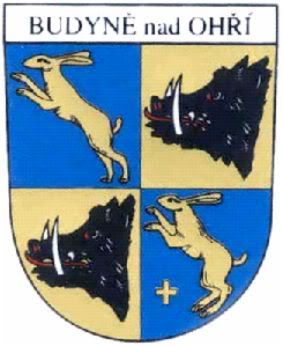
Thanks for the direction. However, the house of Lepus would not have been allies of the Hussites.
I was merely hoping to spur some thought of the History surrounding the period I was looking. It is rumored
that some of Prague Cathedral's vestments were hidden in the family castle Hazmburk. It would make a good
hiding spot since it was built on an extinct volcano. The documents I've been able to uncover from a cousin over seas
include some accounts of Wilhelmus dictus Lepus cognomen Leporis. Wilhelmus defeated Fredrick of Austria and formed
some "terms". Obviously he was very regarded as his progeny was a knight and the kings military advisor (at 15) and adventually name archbishop of Prague (23 yrs). At the behest of the king, the Pope waived the age requirement and Zbynek Leporis de Hazmburg was archbishop. So, I'm not sure if I'd be looking for a kite with John the blind emblem or not. Perhaps something with a Hare (lepus) or even the the coat of arms for Budyn nad Ohri. For what it's worth Wilhelmus is listed as "of Valdek" and is a descendant of the Buzic family of Valdek castle. There's lots more history I could share. Hopefully it will peak someone's interest in checking their collections (pictures even) for some reference. Incidentally, castle Hazmburk was attacked at least twice by the Hussites and burned down partially but was afterwards still inhabited. I hope everyone will forgive me for knowing nothing of the arms theme per se, but rather I'd like to have such information to supplement the history I have already found so far in Prage University's Latin studies.
filius Leporis (of Lepus/ zajic)

Most of what I said for the hussites could be assumed to be good for their enemies in the area. If you lived near bohemia where the arms industry seems strong then you could get arms, hussite ot not.
Good luck with your search.
RPM
Good luck with your search.
RPM
I am from Czech Republic
What age do you want armour from?I could find some pictures.
And also heavy or light armour?
What age do you want armour from?I could find some pictures.
And also heavy or light armour?
Dawit,
That would be very kind of you, thank you. I am most interested in the 13th through the 16th century.
However, anything would be considered a valuable clue.
That would be very kind of you, thank you. I am most interested in the 13th through the 16th century.
However, anything would be considered a valuable clue.
I am studing circa 1250-1350 and in this time I could say in book ilustration ,there is no diference like in another westren countries (German , French , Britain)
In early 14th is still very poplular Ring mail (with hands and coif) sometimes with some easier metal armour (depend on the rank).
If I will talk in main stream ring mail complet still hold to 1350 ,where are on richer wariors some metal armour(shin pads , knee , elbow and also brigantine(or coat of plates) is more used.
From ring mail was removed hand and coif is ussually attached on the helmets.
In next time I will add some pictures.
In early 14th is still very poplular Ring mail (with hands and coif) sometimes with some easier metal armour (depend on the rank).
If I will talk in main stream ring mail complet still hold to 1350 ,where are on richer wariors some metal armour(shin pads , knee , elbow and also brigantine(or coat of plates) is more used.
From ring mail was removed hand and coif is ussually attached on the helmets.
In next time I will add some pictures.
In western Europe by 1320-1330 the amount of plate armour for most knights is almost a given. You of course will have a knee length elbow long sleeved hauberk and aketon under the plate. Plate was integrated by this time though as many early 14th effigies and artowrk show. Blair made the satement that by 1320 no knight inventory fails to posseses at least one COP, more often than not more are listed. That said the common soldier or perhaps lesser men at arms might not be so well equipped, but as you are speaking about a person with huge disposable income he'd have the best.
By 1350 you begin to see complete limb defenses in English effigies with the protohourglass gauntlets appearing. The first complete one piece breastplates seem to have developed in the 1st half of the 14th as well. By the 1350's Prince Edward is giving them away as a gift so clearly the uppers have them.
RPM
By 1350 you begin to see complete limb defenses in English effigies with the protohourglass gauntlets appearing. The first complete one piece breastplates seem to have developed in the 1st half of the 14th as well. By the 1350's Prince Edward is giving them away as a gift so clearly the uppers have them.
RPM
Here are some pictures of effigies, English ones as I do not have any pre1350 german effigies that may give you more of an idea what to look into but the best I could do.
Aymer de Valance 1320's.
De Bacon Family Effigy 1320's.
William FitzRalph 1320's.
I do have some post 1350's german effigies if you'd like.
RPM
 Attachment: 20.88 KB
Attachment: 20.88 KB
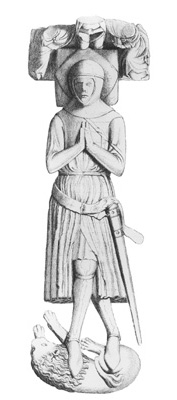
 Attachment: 31.07 KB
Attachment: 31.07 KB
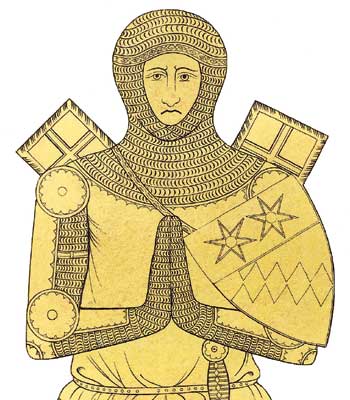
 Attachment: 22.84 KB
Attachment: 22.84 KB
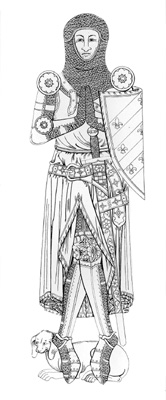
Aymer de Valance 1320's.
De Bacon Family Effigy 1320's.
William FitzRalph 1320's.
I do have some post 1350's german effigies if you'd like.
RPM



Randall,
That is great! That's is what I'm looking for but cannot find a good source of these images.
The symbolism is wonderful in these effigies. I'd love the German effigies too as their influence
is undeniable.
Thanks very much.
That is great! That's is what I'm looking for but cannot find a good source of these images.
The symbolism is wonderful in these effigies. I'd love the German effigies too as their influence
is undeniable.
Thanks very much.
Here are a few more effigies of German origin all date after 1350 sadly but someone may have some good earlier effigies than I do. There clearly are differences between the german and English effigies. There are a number of books on effigies out but I do not know of a specifically german one. If you can look at the osprey german armies 1300-1500 they have some good info on arms and armour etc. but it is a good starting point not foundation. The first is from 1369 and the rest 1370. The last one is Hungarian.
RPM
 Attachment: 24.18 KB
Attachment: 24.18 KB
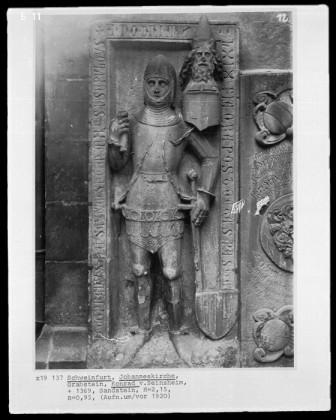
 Attachment: 18.19 KB
Attachment: 18.19 KB
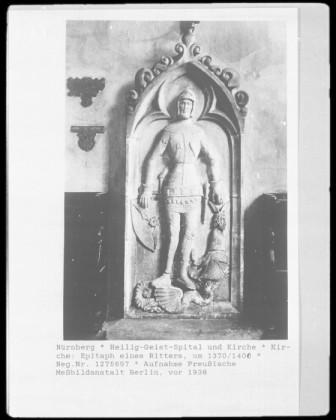
 Attachment: 20.6 KB
Attachment: 20.6 KB
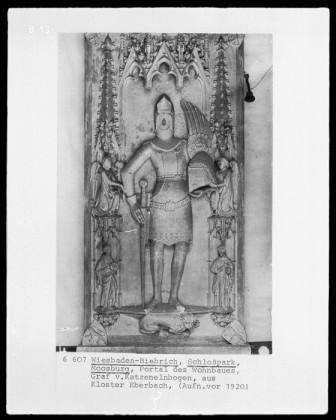
 Attachment: 25.89 KB
Attachment: 25.89 KB
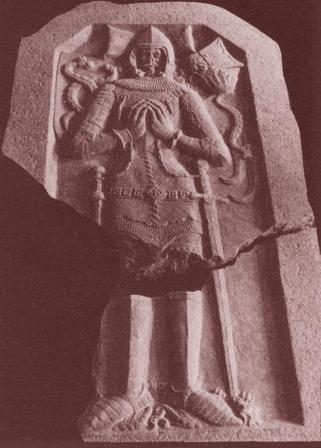
RPM




My opionion is on the scuptures can be seen more details ,but they were made for the people which have money and importance to let them made. So the armour many be sometimes be supertemporal ,not talking about that time where they was made in main stream and typicalness.
Some czech sources
Pasionál Abatyše Kunhůty (1313-1321) - http://www.e-stredovek.cz/upload/ulozene/pasi...uty06v.jpg
scene from capturing the Christ ,if you look on the sleeve ,and think it is stylization ,because painter use fashion which was in early 14th on ring mail like it was tunic or normal shirt.
If you can speak czech ,here is some list of sources (100-1350) from seals , coins, murals , illumination ,sculputes , wood painting...
http://www.sweb.cz/militessanctipetri/Publika...01350.html
Some czech sources
Pasionál Abatyše Kunhůty (1313-1321) - http://www.e-stredovek.cz/upload/ulozene/pasi...uty06v.jpg
scene from capturing the Christ ,if you look on the sleeve ,and think it is stylization ,because painter use fashion which was in early 14th on ring mail like it was tunic or normal shirt.
If you can speak czech ,here is some list of sources (100-1350) from seals , coins, murals , illumination ,sculputes , wood painting...
http://www.sweb.cz/militessanctipetri/Publika...01350.html
Dawitt,
That is fine but the written records suppost the fact that plate was used by the great part of English knights by 1320-1330 so it is pretty clear they were. By 1330's Edward III made Coat of Plates, bascients with visors and gauntlets required for men at arms and hobelars, noble or common as well. Whether it was so in the eastern part of Europe I do not know.
RPM
That is fine but the written records suppost the fact that plate was used by the great part of English knights by 1320-1330 so it is pretty clear they were. By 1330's Edward III made Coat of Plates, bascients with visors and gauntlets required for men at arms and hobelars, noble or common as well. Whether it was so in the eastern part of Europe I do not know.
RPM
Which reconds it speaks about common?
What is it hobelars? Is it ring mail fist?
How you descibe it seems like from Romance of Alexandr
earlier (1320-1330) - http://image.ox.ac.uk/images/bodleian/ms.bodl.264/21v.jpg
latest part 1344 - http://image.ox.ac.uk/images/bodleian/ms.bodl.264/43v.jpg
- http://image.ox.ac.uk/images/bodleian/ms.bodl.264/51v.jpg
I think the diferrence is easy to see ,also in fashion and it is only 10-15 years.
What is it hobelars? Is it ring mail fist?
How you descibe it seems like from Romance of Alexandr
earlier (1320-1330) - http://image.ox.ac.uk/images/bodleian/ms.bodl.264/21v.jpg
latest part 1344 - http://image.ox.ac.uk/images/bodleian/ms.bodl.264/43v.jpg
- http://image.ox.ac.uk/images/bodleian/ms.bodl.264/51v.jpg
I think the diferrence is easy to see ,also in fashion and it is only 10-15 years.
Basically starting around 1320 the inventories that survive in England and the ones I have seen of France indicate the coat of plates is basically a mainstay. Claude Blair (Who just turned 85 this week) states that by 1320 the COP was part of bascially every knights equipment in western europe. By this time greaves, poleyns and gaauntlets are extremely common in England and couters and other things not rare. There are a fair number of random armour related accounts form the Close and Patent Rolls, calendaer of letter books of London... all sorts of them that indicate plate common by the 2nd quarter of the 14th.
Here are two such accounts-
'In the reign of Edward II (1322) the equipment of a man at arms was actually listed as part of an inquest to see if London merchants had raised their prices to overcharge the kings’ men for an army he had outfitted. The lists of equipment identified hundreds of ‘bascineets, aketons, and gloves of iron.’ (Letter books of London E, p. 170) Thus we can gather that an armed man was wearing a padded garment that probably covered the full torso, a helmet that covered his head but probably was open-faced, and iron plate gauntlets. In 1337 Edward III listed his requirements for men at arms, which is similar to what his father listed, except it included a visor on the helmet, or possibly an aventail for throat protection, and plates which probably referred to a type of torso protection made of overlapping plates bound to a fabric or leather shell. (Letter Books F, 33).'
From 1322 Patent Rolls, p. 251.- This armour is inventoried as: pairs of plates, bascinets, collarets, gauntlets, cuisses, greaves and other armour for the munition of sixteen men.
Now if commoners are able to get ahold of such equipment in 1322 it would seem hard to fathom knights and their betters not being able to or gettign it for themselves even earlier.
A hobelar is a unit from the British Isle that was less heavily armed than a men at arms but mounted, at least to get to where the battle was taking place. Their exact use is not completely known, some think they fought at times mounted some think they never did.
Ring mail is mail right. Mail was always the primary armour used by the armoured class in the 1st half of the 14th. That does not mean it is used mostly alone. The romance of Alexander is a great example of the early plate/mix mail. Even in the circa 1320 section plate is on almost every man, greaves, poleyns, etc. The latest date of the book is 1344 so it likely would be that the art is portraying at the latest 1320's-1330's.
RPM
Here are two such accounts-
'In the reign of Edward II (1322) the equipment of a man at arms was actually listed as part of an inquest to see if London merchants had raised their prices to overcharge the kings’ men for an army he had outfitted. The lists of equipment identified hundreds of ‘bascineets, aketons, and gloves of iron.’ (Letter books of London E, p. 170) Thus we can gather that an armed man was wearing a padded garment that probably covered the full torso, a helmet that covered his head but probably was open-faced, and iron plate gauntlets. In 1337 Edward III listed his requirements for men at arms, which is similar to what his father listed, except it included a visor on the helmet, or possibly an aventail for throat protection, and plates which probably referred to a type of torso protection made of overlapping plates bound to a fabric or leather shell. (Letter Books F, 33).'
From 1322 Patent Rolls, p. 251.- This armour is inventoried as: pairs of plates, bascinets, collarets, gauntlets, cuisses, greaves and other armour for the munition of sixteen men.
Now if commoners are able to get ahold of such equipment in 1322 it would seem hard to fathom knights and their betters not being able to or gettign it for themselves even earlier.
A hobelar is a unit from the British Isle that was less heavily armed than a men at arms but mounted, at least to get to where the battle was taking place. Their exact use is not completely known, some think they fought at times mounted some think they never did.
Ring mail is mail right. Mail was always the primary armour used by the armoured class in the 1st half of the 14th. That does not mean it is used mostly alone. The romance of Alexander is a great example of the early plate/mix mail. Even in the circa 1320 section plate is on almost every man, greaves, poleyns, etc. The latest date of the book is 1344 so it likely would be that the art is portraying at the latest 1320's-1330's.
RPM
Page 1 of 1
You cannot post new topics in this forumYou cannot reply to topics in this forum
You cannot edit your posts in this forum
You cannot delete your posts in this forum
You cannot vote in polls in this forum
You cannot attach files in this forum
You can download files in this forum
All contents © Copyright 2003-2006 myArmoury.com — All rights reserved
Discussion forums powered by phpBB © The phpBB Group
Switch to the Full-featured Version of the forum
Discussion forums powered by phpBB © The phpBB Group
Switch to the Full-featured Version of the forum